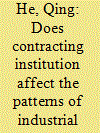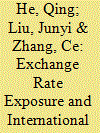| Srl | Item |
| 1 |
ID:
170095


|
|
|
|
|
| Summary/Abstract |
This study evaluates the importance of contracting institutions as a source of comparative advantage across Chinese provinces. We find that industries differ in their reliance on relationship-specific investments. Provinces with better contracting institutions specialize in industries with more intensive relationship-specific investments. We implement two proxies to measure contracting institutions, including efficiency of the legal system and service of contract enforcement. The empirical results of this study indicate that contracting institutions play a role in shaping the patterns of industrial specialization. Specifically, the service of contract enforcement has the first-order effect on the patterns of industrial specialization in China; by contrast, legal jurisdiction plays a modest role.
|
|
|
|
|
|
|
|
|
|
|
|
|
|
|
|
| 2 |
ID:
180468


|
|
|
|
|
| Summary/Abstract |
This study analyzes how exchange rate risk exposure and foreign industry competition affect Chinese industries. Using the data from 2005 to 2018, the authors find that industry competition from the US has a statistically significant influence on 33.3 percent of Chinese industries. Unsurprisingly, tradable goods benefit more from depreciation of the Renminbi against the US dollar. Counterintuitively, only 20 percent of the industries supported by the ‘Made in China 2025’ initiative is sensitive to US industrial competition. In addition, on average Chinese industries face international competition from few developed countries, such as the Netherlands; and depreciation of RMB against the Japanese yen is hurting Chinese industries on average. Developing countries, however, exert marginal competition effects on their Chinese counterparts in the sample period.
|
|
|
|
|
|
|
|
|
|
|
|
|
|
|
|
| 3 |
ID:
182722


|
|
|
|
|
| Summary/Abstract |
This paper investigates the foreign exchange rate exposure and its determinants using the data of all firms listed on the Chinese stock market from 2005 to 2018. We find significantly linear and nonlinear exposures to bilateral as well as multilateral foreign exchange rates. Our temporal study also shows that considerably more Chinese firms were exposed to exchange rate fluctuations after the major exchange rate reform in 2015. We find a negligible role played by international operations of firms in explaining exposures. The level of exchange rate exposure is primarily explained by variables that are proxies for a firm's hedging costs. Larger firms, or firms with less leverage ratio, tend to have smaller exposures. Exposure is found to increase with a firm's growth opportunity. Last but not least, we find that leverage ratios and growth opportunities impact more significantly on exposures for firms with separation of control and cash flow rights.
|
|
|
|
|
|
|
|
|
|
|
|
|
|
|
|
| 4 |
ID:
134885


|
|
|
|
|
| Summary/Abstract |
The volatility of Chinese GDP growth has been markedly lower since the mid-1990s. We utilize frequency domain and vector autoregression (VAR) methods to investigate the origin of the observed volatility reduction in the Chinese economy. Our estimation indicates that lower volatility of random shocks to the economy, or the good luck hypothesis, accounts for most of the decline in macroeconomic volatility. Although good policy and better business practices are also contributing factors, they play a marginal role in dampening China's economic fluctuations.
|
|
|
|
|
|
|
|
|
|
|
|
|
|
|
|
| 5 |
ID:
092531


|
|
|
|
|
| Publication |
2009.
|
| Summary/Abstract |
This paper investigates the sources of economic fluctuations in China since its reform that started in 1978. Using the framework of a standard neoclassical open economy model with time-varying frictions (wedge), we study the relative contribution of the efficiency, labor, investment and foreign debt wedges to the business cycles of China. The business accounting procedure suggests that productivity best explains the behavior of aggregate economic variables in China throughout the period of 1978-2006. The labor wedge plays a major role in explaining the movement of labor force. The foreign debt wedge and investment wedge primarily affect the composition of output, but their role in explaining the movement of output is modest. Our results suggest that the focus of government policies should be to combat the problems of inefficient factor utilization and labor market rigidity.
|
|
|
|
|
|
|
|
|
|
|
|
|
|
|
|